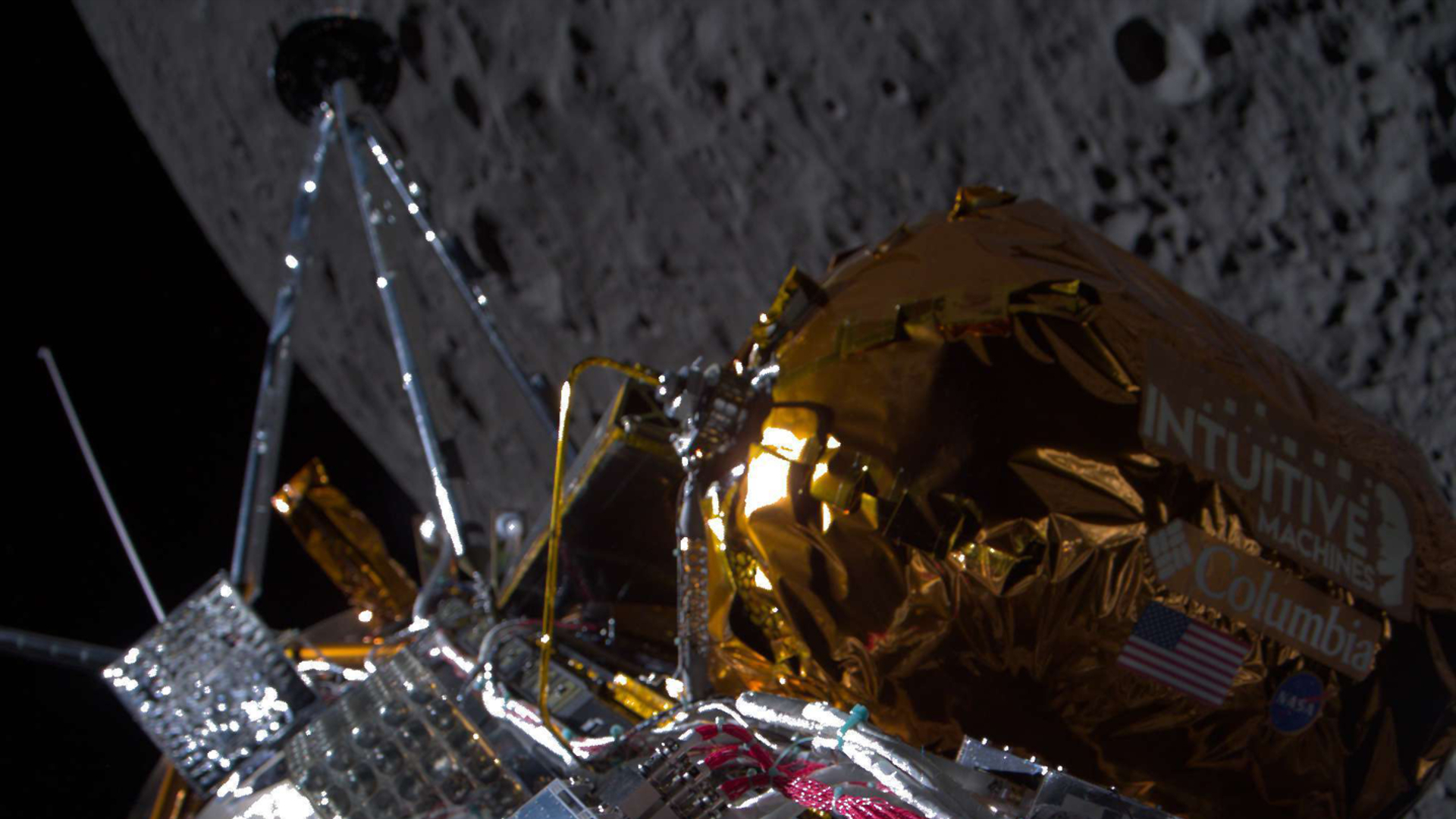Intuitive Machines lands on moon in nail-biting descent of private Odysseus lander, a 1st for US since 1972
After a nail-biting descent and a tense silence from the lunar surface, the United States is back on the moon.
Odysseus, a robotic lander built by Houston-based company Intuitive Machines, touched down near the lunar south pole this evening (Feb. 22).
It was a landmark moment for space exploration: No private spacecraft had ever soft-landed on the moon before, and an American vehicle hadn't hit the gray dirt softly since NASA's crewed Apollo 17 lander did so in December 1972.
"What a triumph! Odysseus has taken the moon," NASA Administrator Bill Nelson said in a video message the agency aired just after confirmation of a successful touchdown. "This feat is a giant leap forward for all of humanity. Stay tuned!"
Related: Missions to the moon: Past, present and future
Returning to the moon
The moon was a frequent target for American spacecraft during the 1960s and early 1970s. This push didn't come from mere scientific curiosity: Landing astronauts on Earth's nearest neighbor was viewed as a national security imperative, a way to demonstrate technological superiority over the nation's Cold War rival, the Soviet Union.
The U.S. famously put 12 astronauts on the lunar surface over the course of six Apollo missions from 1969 to 1972. With the moon race thus definitively won, NASA was directed to focus on other goals for its human spaceflight program — chiefly, the development and operation of the space shuttle program.
Breaking space news, the latest updates on rocket launches, skywatching events and more!
The U.S. launched a number of robotic moon probes after the Apollo era; NASA's sharp-eyed Lunar Reconnaissance Orbiter has been circling the moon since 2009, for example. But, some frustrating fits and starts notwithstanding, getting back to the surface was not a priority — until recently.
In December 2017, then-President Donald Trump ordered NASA to return astronauts to the moon in the relatively near future. This directive gave rise to a broad and ambitious program called Artemis, which aims to establish a long-term, sustainable human presence on and around the moon by the end of the 2020s — and to use the knowledge gained in doing so to help get astronauts to Mars by the late 2030s or early 2040s.
NASA plans to set up one or more Artemis bases in the moon's southern polar region, which is thought to harbor lots of water ice. Before sending astronauts there, however, the agency wants to collect more data about this little-explored area — to help determine, for example, just how much water it contains and how easy this crucial resource is to access.
So NASA established another program called CLPS ("Commercial Lunar Payload Services"), which books rides for agency science instruments on robotic moon landers built by American companies.
"The goal here is for us to investigate the moon in preparation for Artemis, and really to do business differently for NASA," Sue Lederer, CLPS project scientist at Johnson Space Center in Houston, said during a press conference on Feb. 12. "One of our main goals is to make sure that we develop a lunar economy."
And that's where Intuitive Machines comes in.
Related: The 10 greatest images from NASA's Artemis 1 moon mission
Sending NASA science to the moon
In 2019, CLPS selected Intuitive Machines to deliver a batch of NASA science instruments to the lunar surface using the company's Nova-C lander, which is about the size of a British telephone booth.
After some modifications, the task order turned out to be worth $118 million, NASA officials said recently. It covered the transport of six agency experiments and technology demonstrations on Intuitive Machines' first lunar mission, which the company calls IM-1. That mission features a Nova-C vehicle named Odysseus, after the famous voyaging hero in Greek mythology.
The NASA instruments, which cost the agency an additional $11 million to develop, are designed to conduct a variety of investigations. For instance, one of them, called NDL ("Navigation Doppler Lidar for Precise Velocity and Range Sensing") used LIDAR (light detection and ranging) technology to collect data during descent and landing. NDL turned out to be vital to today's touchdown, as you'll see below.
Another instrument was designed to study how the spacecraft's engine exhaust interacts with lunar dirt and rock. Yet another will demonstrate autonomous positioning tech, which could eventually become part of a broad, GPS-like navigation system on and around the moon.
Intuitive Machines also put six commercial payloads on Odysseus for IM-1. One of them comes from Columbia Sportswear, which wanted to test its "Omni-Heat Infinity" insulative material in deep space. Another is a set of sculptures by the artist Jeff Koons, and there's even a "secure lunar repository" that aims to help preserve humanity's storehouse of accumulated knowledge.
Also flying on Odysseus was EagleCam, a camera system built by students at Embry-Riddle Aeronautical University. EagleCam was designed to deploy from Odysseus about 100 feet (30 meters) above the lunar surface and snap photos of the lander's epic touchdown from below. You can learn more about all 12 of the IM-1 payloads here.
Making history
Those 12 payloads lifted off on Feb. 15, when a SpaceX Falcon 9 rocket sent Odysseus toward the moon. The lander's deep-space trek was short and relatively smooth, though things got a bit sporty toward the end.
Odysseus arrived in lunar orbit yesterday (Feb. 21) as planned. In the home stretch of its touchdown try today, however, the lander's handlers discovered that Odysseus' laser rangefinders, which allow it to determine its altitude and horizontal velocity, weren't working properly. So the team pressed NASA's experimental NDL payload into service for this vital function, pushing the landing try back by two hours to put the new plan into action.
This last-minute workaround — which required the team to design a software patch on the ground and beam it up to Odysseus — did the trick. At 6:11 p.m. EST (2311 GMT) today, Odysseus fired up its main engine for a crucial 11-minute burn that slowed the craft's descent toward the lunar surface. Then, at 6:23 p.m. EST (2353 GMT), Odysseus touched down softly near the rim of the crater Malapert A, about 190 miles (300 kilometers) from the lunar south pole.
Success wasn't immediately apparent, however. It took about 15 tense minutes for the IM-1 team to latch onto Odysseus' signal.
"What we can confirm without a doubt is, our equipment is on the surface of the moon and we are transmitting," mission director Tim Crain said after that milestone moment. "Odysseus has found his new home."
If all goes according to plan, the lander and its payloads will now operate for about seven Earth days on the lunar surface. IM-1 will end when the sun goes down at Malapert A, as Odysseus was not designed to survive the bitter cold of the long lunar night. (It takes the moon more than 27 Earth days to rotate once on its axis, so each lunar night lasts roughly two weeks.)
IM-1 is part of a newly energized march to the moon. For example, Pittsburgh company Astrobotic launched its Peregrine lunar lander last month on the first flight of United Launch Alliance's Vulcan Centaur rocket.
But Peregrine, which also carried NASA payloads via the CLPS program, suffered a crippling fuel leak just after deploying from the rocket's upper stage. The problem prevented Peregrine from making it to the moon, and Astrobotic ultimately steered it to a controlled demise in Earth's atmosphere on Jan. 18.
Two other private moon landers made it to lunar orbit recently — the Israeli Beresheet probe and Hakuto-R, which was built by Tokyo-based company ispace. Still, neither one could take the big next step; Beresheet crashed during its landing attempt in April 2019, and Hakuto-R suffered the same fate in April 2023.
National governments are increasingly shooting for the moon as well.
Last August, for instance, India put its robotic Chandrayaan-3 mission down near the lunar south pole. And just last month, Japan landed its own moon probe, called SLIM. It was the first such success for each nation; they've now joined the lunar party, which already included the Soviet Union, the U.S. and China.
And some of these countries have even bigger lunar ambitions.
There's the U.S. with its Artemis program, of course. But China also aims to put astronauts on the moon by 2030 and is working (with Russia and several other nations) to develop a lunar outpost later in that decade as well. India, meanwhile, has said it wants to put boots down on Earth's natural satellite in 2040 or thereabouts.
Some politicians have characterized this planned activity as a new moon race, a competition between the U.S. and China for the right to establish precedents and norms of behavior in the high frontier. Exploration advocates, however, tend to see the rosier side, stressing the coming exploitation of lunar resources that could help humanity extend its footprint out into the solar system for the first time.
Either way, the moon is coming into sharper focus for nations and businesses around the world. It's going to get busier and busier up there.

Michael Wall is a Senior Space Writer with Space.com and joined the team in 2010. He primarily covers exoplanets, spaceflight and military space, but has been known to dabble in the space art beat. His book about the search for alien life, "Out There," was published on Nov. 13, 2018. Before becoming a science writer, Michael worked as a herpetologist and wildlife biologist. He has a Ph.D. in evolutionary biology from the University of Sydney, Australia, a bachelor's degree from the University of Arizona, and a graduate certificate in science writing from the University of California, Santa Cruz. To find out what his latest project is, you can follow Michael on Twitter.


